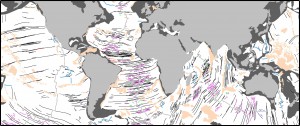 We present a global community data set of fracture zones (FZs), discordant zones, propagating ridges, V-shaped structures and extinct ridges, digitized from vertical gravity gradient (VGG) maps.
We present a global community data set of fracture zones (FZs), discordant zones, propagating ridges, V-shaped structures and extinct ridges, digitized from vertical gravity gradient (VGG) maps.
… Read more…
Geochemistry Geophysics Geosystems – Spherical dynamic models of top-down tectonics
Morra, G., Quevedo, L., & Müller, R. D. (2012). Spherical dynamic models of top‐down tectonics. Geochemistry, Geophysics, Geosystems, 13(3). doi:10.1029/2011GC003843. Download the paper – pdf
